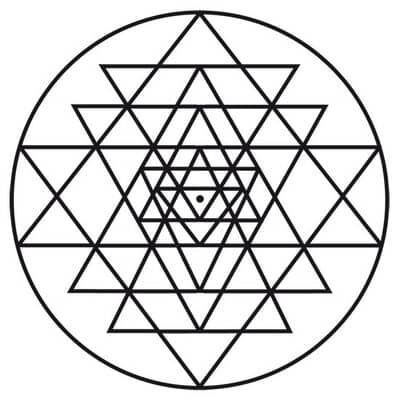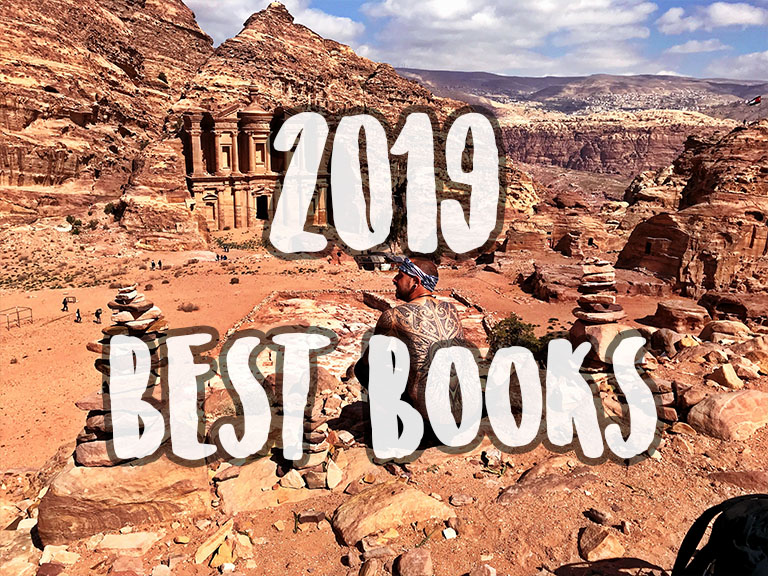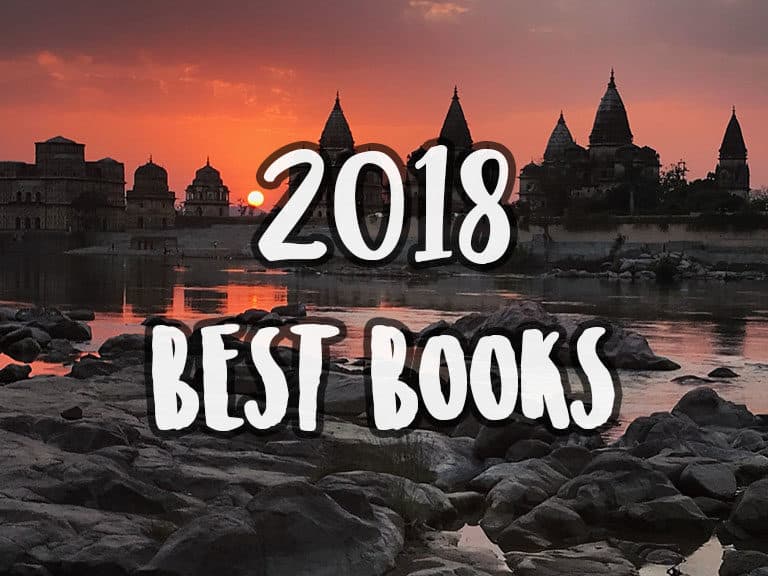The 15 Best Books of 2017
The 15 Best Books of 2017
LIST UPDATED!! The annual books list has been updated in a new post with the selection of the best books of 2018.
Just follow the link to discover this year’s awesome selection in The 15 best books of 2018
Welcome to the annual review of the best books I read during 2017. This year was sooo full of great books!
I am really proud I kept the habit of reading a little bit of everything. I have to admit that this is one of my favorite pleasures in the world since I was really young. And I truly think that this habit really helps you to increase your knowledge and be more tolerant and open-minded. The same you obtain from traveling, right??? 🙂
This year I read some of the best-seller most recommended popular books on the blog scene of coaching and top-performing, but I also enjoyed so much with some travel classics and of course some Buddhist, sacred and spiritual ones, as this is my path in life, Soulsearching!
This is a selection of my favorite ones I read this year, in no particular order, my list with the 15 best books of 2017. I hope you enjoy your reading:
Best Books of 2017 suggested by eLPuTocaRDi
15. Charles Duhigg – The Power of Habit
In The Power of Habit, Pulitzer Prize–winning business reporter Charles Duhigg takes us to the thrilling edge of scientific discoveries that explain why habits exist and how they can be changed. Distilling vast amounts of information into engrossing narratives that take us from the boardrooms of Procter & Gamble to sidelines of the NFL to the front lines of the civil rights movement, Duhigg presents a whole new understanding of human nature and its potential. At its core, The Power of Habit contains an exhilarating argument: The key to exercising regularly, losing weight, being more productive, and achieving success is understanding how habits work. As Duhigg shows, by harnessing this new science, we can transform our businesses, our communities, and our lives.
14. Thich Naht Hanh – Peace Is Every Step
In the rush of modern life, we tend to lose touch with the peace that is available in each moment. World-renowned Zen master, spiritual leader, and author Thich Nhat Hanh shows us how to make positive use of the very situations that usually pressure and antagonize us. For him, a ringing telephone can be a signal to call us back to our true selves. Dirty dishes, red lights, and traffic jams are spiritual friends on the path to “mindfulness”the process of keeping our consciousness alive to our present experience and reality.
Lucidly and beautifully written, Peace Is Every Step contains commentaries and meditations, personal anecdotes and stories from Nhat Hanh’s experiences as a peace activist, teacher, and community leader.
13. Khenchen Sherab Rinpoche – The Heart Sutra
The Heart Sūtra (Sanskrit Prajñāpāramitāhṛdaya or 心經 Xīnjīng) is a popular sutra in Mahāyāna Buddhism. Its Sanskrit title, Prajñāpāramitāhṛdaya, can be translated as “The Heart of the Perfection of Wisdom”. The Heart Sūtra is often cited as the best-known and most popular Buddhist scripture. It is especially popular in East Asia and is highly respected by Tibetan Buddhism.
This sacred meditation is one of the most important philosophical and religious works of all time. Emanating from the Mahayana Buddhist tradition, it is composed of a series of aphorisms that explore the Prajñaparamita or Transcendent Wisdom.
Khenchen Tsewang Gyatso Rinpoche is one of the three senior Khenpos (Abbots) at Ngagyur Nyingma Institute, the prestigious Buddhist studies and research center in Bylakuppe, India.
12. Daniel Kahneman – Thinking fast and slow
In the international bestseller, Thinking, Fast and Slow, Daniel Kahneman, the renowned psychologist and winner of the Nobel Prize in Economics, takes us on a groundbreaking tour of the mind and explains the two systems that drive the way we think. System 1 is fast, intuitive, and emotional; System 2 is slower, more deliberative, and more logical.
Engaging the reader in a lively conversation about how we think, Kahneman reveals where we can and cannot trust our intuitions and how we can tap into the benefits of slow thinking. He offers practical and enlightening insights into how choices are made in both our business and our personal livesand how we can use different techniques to guard against the mental glitches that often get us into trouble.
11. Massimo Pigliucci – How to be a stoic
Whenever we worry about what to eat, how to love, or simply how to be happy, we are worrying about how to lead a good life. No goal is more elusive. In How to Be a Stoic, philosopher Massimo Pigliucci offers Stoicism, the ancient philosophy that inspired the great emperor Marcus Aurelius, as the best way to attain it. Stoicism is a pragmatic philosophy that focuses our attention on what is possible and gives us perspective on what is unimportant. By understanding Stoicism, we can learn to answer crucial questions: Should we get married or divorced? How should we handle our money in a world nearly destroyed by a financial crisis? How can we survive great personal tragedy?
Whoever we are, Stoicism has something for us, and How to Be a Stoic is the essential guide.
10. Marco Aurelio – Meditations
The philosophy of the Roman Emperor Marcus Aurelius can be found in a collection of personal writings known as the Meditations. These reflect the influence of Stoicism and, in particular, the philosophy of Epictetus, the Stoic.
The Meditations may be read as a series of practical philosophical exercises, following Epictetus’ three topics of study, designed to digest and put into practice philosophical theory. Central to these exercises is a concern with the analysis of one’s judgments and a desire to cultivate a “cosmic perspective.”
09. Buddhadasa Bhikkhu – Mindfulness with breathing
This book contains beloved Thai meditation master Buddhadasa Bhikkhu’s explanation of one of the most universal of all Buddhist meditation practices, “mindfulness with breathing.” Using a straight-forward style of presentation suited to a Western audience, Buddhadasa Bhikkhu provides all you need to know to become free of stress and worry through the “simple and beautiful act of sitting quietly, alive to the breathing,” as taught by Buddha in his Anapanasati Sutta.
Ajahn Buddhadasa (1906-1993) is perhaps the most influential Buddhist teacher in the history of Thailand. In 1932 he founded Wat Suan Mokkhablarama, one of the first forest monasteries in Thailand. Since the 1960s his work has helped inspire a new generation of socially concerned individuals around the world. He is the author of numerous works, including Heartwood of the Bodhi Tree: The Buddha’s Teaching on Voidness.
08. Tim Ferriss – Tools of Titans
The tactics, routines, and habits of billionaires, icons, and world-class performers. The book’s content consists of tactics and routines from some of the most popular guests on The Tim Ferriss Show podcast.
TIM FERRISS has been called “a cross between Jack Welch and a Buddhist monk” by The New York Times. He is one of Fast Company’s “Most Innovative Business People” and an early-stage tech investor/advisor in Uber, Facebook, Twitter, Shopify, Duolingo, Alibaba, and 50+ other companies. He is also the author of four #1 New York Times and Wall Street Journal bestsellers: The 4-Hour Workweek, The 4-Hour Body, The 4-Hour Chef, and Tools of Titans.
07. Rolf Potts – Vagabonding
Vagabonding is about taking time off from your normal life—from six weeks to four months to two years—to discover and experience the world on your own terms. Veteran shoestring traveler Rolf Potts shows how anyone armed with an independent spirit can achieve the dream of extended overseas travel. Potts gives the necessary information on:
• financing your travel time
• determining your destination
• adjusting to life on the road
• working and volunteering overseas
• handling travel adversity
• re-assimilating back into ordinary life
Not just a plan of action, vagabonding is an outlook on life that emphasizes creativity, discovery, and the growth of the spirit.
06. Carlo Taglia – Vagamondo: Around the World without flying
Report of a world tour done without flying. 95,450 km, 528 days and 24 countries were crossed to accomplish this extraordinary experience, alone. An exciting journey that started in the Himalayas and ended in Siberia, during which Oceans were crossed on merchant ships. A journey not only through wonderful places on Earth, but most of all a powerful, spiritual experience, marked by an introspective evolution lived country after country by a traveller of our times.
Travelling considered as medicine for the soul, to cure the malaise inherited in adolescence from the consumer society he comes from, which lead to drug and alcohol abuse. This is not a conventional guide, it is much more, it is a genuine, authentic story of life.
05. Jondix – Shakti-7
Shakti-7 is a collection of 120 plates with illustrations and classic images drawn from Tibetan, Hindu and Thai culture, reinterpreted by the great tattoo master Jondix, one of the most highly esteemed artists in the Oriental style. This flash collection is an inexhaustible source of inspiration and a vital tool for any tattoo artist dealing with the iconography and symbolism of these ancient Oriental cultures.
«In hindi “shakti” is the name of a type of energy from nature that helps you getting things done, that allows you to be able to create. But we don’t have this word in the west, we would simply use the word “power” instead, which I don’t like that much if you use it all alone. And that’s why my Hindu friend Manoj advised me to add my favorite number next to it, seven… It is also a little connection with my shop in London: Seven Doors Tattoo.»
04. Tashi Mannox – Sacred Scripts
“Sacred Scripts – A Meditative Journey Through Tibetan Calligraphy” is an inspiring book from my favorite Tibetan sacred calligraphy artists: Tashi Mannox.
“With its exquisite calligraphy and magnificent photographs of Buddhist imagery, Sacred Scripts presents the refined and varied artistry of Tibetan calligraphers and artists of the past. The work portrayed in this fine volume reflects the great heights of aesthetic achievement attained by master artisans who considered their accomplishments to be offerings to the Buddha, Dharma, and Sangha.” [Dalai Lama].
03. The Rough guide to India
Thoroughly revised and revamped with expanded coverage for its tenth edition, The Rough Guide to India is the ultimate travel guide to one of the world’s great travel destinations. From the majestic landscapes of the Himalayas to the tropical backwaters of Kerala, the Rough Guide covers this endlessly fascinating country in unparalleled depth, with crystal-clear mapping and stunning photography throughout. Rough Guides’ team of experts bring you all the major headline sights, from the “Golden Triangle” of Delhi, Agra and Rajasthan to the beaches of Goa, and insider knowledge on new and off-the-beaten-track destinations, such as up-and-coming beach resorts and newly created wildlife reserves, with the most reliable background coverage available.
Whether you’re planning the holiday of a lifetime or a six-month backpacking adventure, The Rough Guide to India will ensure you don’t miss a thing.
02. Patwant Singh – The Sikhs
A comprehensive history of both the Sikh people and religion traces the origins of the sect five centuries ago in India and discusses its current, sometimes violent, role in Indian politics. Reprint. 10,000 first printing.years ago, Guru Nanak founded the Sikh faith in India. The Sikhs defied the caste system; rejected the authority of Hindu priests; forbade magic and idolatry; and promoted the equality of men and women — beliefs that incurred the wrath of both Hindus and Muslims.
Patwant Singh gives us the compelling story of the Sikhs — their origins, traditions and beliefs, and more recent history. He shows how a movement based on tenets of compassion and humaneness transformed itself, of necessity, into a community that values bravery and military prowess as well as spirituality.
01. Stanislav Lem – Star diaries
This is one of my last readings of the year, from one of my fab sci-fi/philosophy/satiric all-time writers. You maybe know him because he wrote Solaris.
Stanislaw Lem‘s set of short stories, written over a period of twenty years, all feature the adventures of space traveller Ijon Tichy and recount him spinning in time-warps, spying on robots, encountering bizarre civilizations and creatures in space and being hopelessly lost in a forest of supernovae.
The Star Diaries is a philosophical satire on technology, theology, intelligence and human nature from one of the greatest of science fiction writers. You are gonna love it!!!
Did you enjoy this post with my books compilation for this year? Are you a bookworm as well?
If you want to receive my new posts with the latest travel tips, books suggestions, sacred places, off the beaten path, local experiences, free travel guides, inspiring pictures and quotes, just join my monthly newsletter.
Don’t worry, we also hate spam! Just enter your name and email in this form to sign up for eLPuTocaRDi:




















